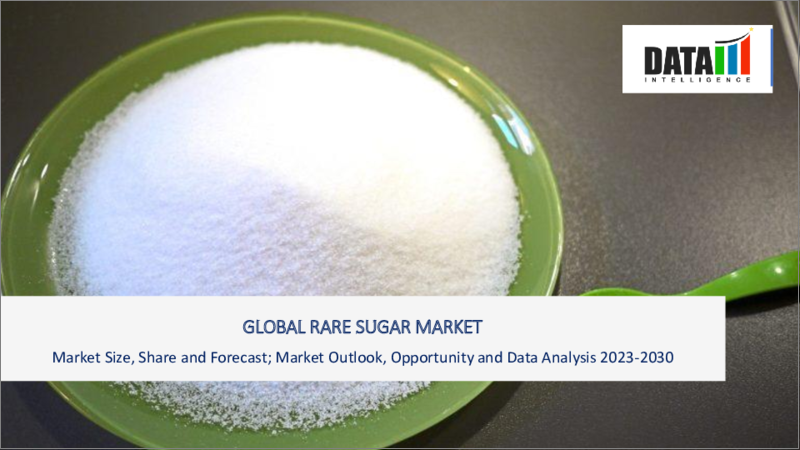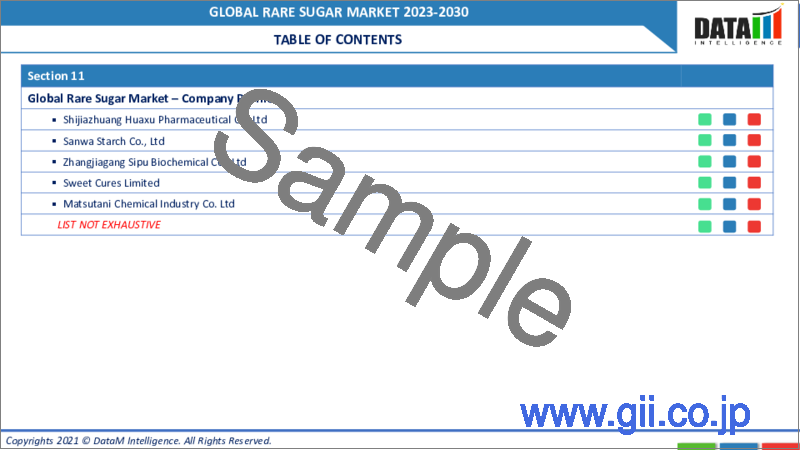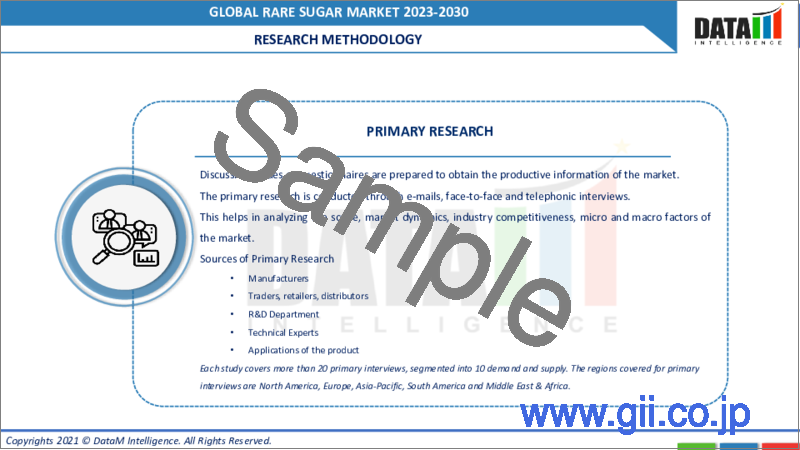|
|
市場調査レポート
商品コード
1262761
希少糖の世界市場-2023-2030Global Rare Sugar Market - 2023-2030 |
||||||
|
● お客様のご希望に応じて、既存データの加工や未掲載情報(例:国別セグメント)の追加などの対応が可能です。 詳細はお問い合わせください。 |
|||||||
| 希少糖の世界市場-2023-2030 |
|
出版日: 2023年04月21日
発行: DataM Intelligence
ページ情報: 英文 202 Pages
納期: 約2営業日
|
- 全表示
- 概要
- 目次
市場概要
世界の希少糖市場は、予測期間中(2023年~2030年)、CAGR4.2%で成長しています。
単糖類とその誘導体は、自然界に驚くほど少量しか存在しない希少な糖類です。単糖類は50種類以上ありますが、大量に存在するのは7種類だけです。これらの糖は、L-アラビノース、D-リボース、D-キシロース、D-フルクトース、D-マンノース、D-ガラクトース、D-グルコースです。残りの糖は希少糖で、甘さは通常の砂糖の70%程度です。
抗ウイルス剤や抗がん剤に使われるヌクレオシド類似体を合成するためのビルディングブロックには、希少糖が使われています。それらは、発酵や酵素変換などの有機的なプロセスを用いて、同じ化合物を作るために準備されます。
希少糖は、天然に存在する量が少ないにもかかわらず、抗ウイルス薬の成分として使用されるなど、多くの重要な用途があります。さらに、グリセミック指数が低いため、低カロリー甘味料としても利用されています。また、免疫抑制作用があるため、抗炎症薬としても利用されています。
市場力学
消費者の健康志向の高まり
希少糖の摂取は、健康志向の高い消費者にメリットを提供するのに役立ちます。例えば、D-マンノース単糖はインスリン反応を鈍らせ、血糖値への影響を軽減するため、様々な機能性食品や飲食品の天然糖分としてより良い代替となります。また、グルコースのように肝臓に蓄積されず、消化管でゆっくりと吸収されるため、グリセミック指数が低く、希少糖市場の成長を後押ししています。フランスと英国では、選択的課税、製品改良、包装前ラベルの説明などを通じて砂糖の消費量を削減する政府の取り組みが、市場の拡大を後押しすると予想されています。これらの取り組みは、WHOの2015-2020年欧州食品・栄養行動計画の、より健康的な食品環境を育むための政策提言をサポートするものです。
国際的な品質基準や規制の遵守
希少糖市場の成長を大きく抑制する要因は、厳格な表示と製造方法によって消費者の利益を守るために設けられた厳しい規制とコンプライアンスにあると予想されます。
例えば、2019年4月、米国食品医薬品局は、栄養やサプリメント用のアルロースのカロリー数に関するガイドラインを制定しました。この法律に基づいて低糖質または低カロリー製品として認定されるには、希少糖の製造業者は厳しい規制を遵守する必要があります。希少糖市場は、こうした要因による課題に直面すると予想されます。
COVID-19の影響度分析
COVID-19の分析には、Pre-COVIDシナリオ、COVIDシナリオ、Post-COVIDシナリオがあり、価格ダイナミクス(パンデミック時およびパンデミック後の価格変動とCOVID前のシナリオとの比較)、需要-供給スペクトラム(取引制限、ロックダウンおよびその後の問題による需要と供給のシフト)、政府の取り組み(政府機関による市場、セクター、産業の活性化に関する取り組み)、メーカーの戦略的取り組み(COVID問題を軽減するためのメーカーの取り組み)についても解説する予定です。
目次
第1章 調査手法とスコープ
- 調査手法
- 調査目的および調査範囲について
第2章 定義と概要
第3章 エグゼクティブサマリー
- 製品別スニペット
- エンドユーザー別スニペット(Snippet by End-User
- 地域別スニペット
第4章 ダイナミックス
- 影響要因
- 促進要因
- 消費者の健康志向の高まり
- 抑制要因
- 国際的な品質基準・規制の遵守
- 機会
- 影響度分析
- 促進要因
第5章 産業分析
- ポーターのファイブフォース分析
- サプライチェーン分析
- 価格分析
- 規制分析
第6章 COVID-19の分析
- COVID-19の解析について
- COVID-19シナリオ前
- 現在のCOVID-19シナリオ
- ポストCOVID-19または将来シナリオ
- COVID-19 の中での価格ダイナミクス
- 需給スペクトル
- パンデミック時の市場に関連する政府の取り組み
- メーカーの戦略的な取り組み
- 結論
第7章 製品別
- D-マンノース
- アリュロース
- L-アラビノース
- L-フコース
- その他
第8章 エンドユーザー別
- 栄養補助食品
- コスメティック&パーソナルケア
- 医薬品
- 飲食品
- その他
第9章 地域別
- 北米
- 米国
- カナダ
- メキシコ
- 欧州
- ドイツ
- 英国
- フランス
- イタリア
- ロシア
- その他欧州
- 南米
- ブラジル
- アルゼンチン
- その他南米地域
- アジア太平洋地域
- 中国
- インド
- 日本
- オーストラリア
- その他アジア太平洋地域
- 中東・アフリカ地域
第10章 競合情勢について
- 競合シナリオ
- 市況分析・シェア分析
- M&A分析
第11章 企業プロファイル
- Ingredion Incorporated
- 会社概要
- 製品ポートフォリオと説明
- 財務概要
- 主な展開
- Nestle
- Avantor, Inc
- Tate & Lyle
- Jarrow Formulas Inc
- Shijiazhuang Huaxu Pharmaceutical Co.,Ltd
- Sanwa Starch Co., Ltd
- Zhangjiagang Sipu Biochemical Co., Ltd
- Sweet Cures Limited
- Matsutani Chemical Industry Co. Ltd
上記以外を含む
第12章 付録
Market Overview
The global rare sugar market reached US$ XX million in 2022 and is projected to witness lucrative growth by reaching up to US$ XX million by 2030. The market is growing at a CAGR of 4.2% during the forecast period (2023-2030).
Monosaccharides and their derivatives, which are present in nature in incredibly small amounts, are rare sugars. There are over 50 different types of simple sugars, but only seven are found in significant quantities. These sugars are L-arabinose, D-ribose, D-xylose, D-fructose, D-mannose, D-galactose and D-glucose. The remaining sugar is rare and has a sweetness level of 70% of regular sugar.
The building blocks to synthesize nucleoside analogs, which are used as antiviral and anti-cancer agents, use rare sugars. They are prepared to create the same compound using organic processes like fermentation or enzyme conversion.
Despite their low natural abundance, rare sugars have many important applications, including their use as components in antiviral medications. Furthermore, because of their low glycemic index, they are used as low-calorie sweeteners. They also serve as anti-inflammatory drugs because of their immunosuppressive qualities.
Market Dynamics
Increase in health consciousness among consumers
The consumption of rare sugar helps in providing benefits for health-conscious consumers. For instance, D-Mannose monosaccharide significantly blunts insulin response and reduces the impact on blood sugar level, thus making it a better alternative as natural sugar in different functional food and beverages. It is also not stored in the liver like glucose and is absorbed more slowly in the gastrointestinal tract, thus accounting for a lower glycemic index, propelling the growth of the rare sugar market. It is anticipated that national government initiatives in France and the U.K. to reduce sugar consumption through selective taxation, product reformulations and explanatory front packaging labels will aid market expansion. These initiatives support WHO's 2015-2020 European Food and Nutrition Action Plan's policy recommendations for fostering a healthier food environment.
Adherence to international quality standards and regulations
It is anticipated that a significant restraint on the growth of the rare sugar market will come from stringent regulations and compliances designed to safeguard consumers' interests through strict labeling and manufacturing practices.
For instance, in April 2019, the U.S. Food and Drug Administration established guidelines on the number of calories in allulose for nutrition and supplementation. To qualify as low-sugar or low-calorie products under this legislation, manufacturers of rare sugar must adhere to stringent regulations. The rare sugar market is anticipated to face challenges due to such factors.
COVID-19 Impact Analysis
The COVID-19 analysis includes Pre-COVID Scenario, COVID Scenario and Post-COVID Scenario along with pricing dynamics (including pricing change during and post-pandemic comparing it with pre-COVID scenarios), demand-supply spectrum (shift in demand and supply owing to trading restrictions, lockdown and subsequent issues), government initiatives (initiatives to revive market, sector or industry by government bodies) and manufacturers strategic initiatives (what manufacturers did to mitigate the COVID issues will be covered here).
Segment Analysis
The global rare sugar market is segmented based on product, end-user and region.
Rising prevalence of urinary tract infections globally
D-Mannose segment in the rare sugar market is expected to hold a significant global market share. D-mannose is often sold as a dietary supplement for lowering the incidence of UTIs. According to research, augmented D-mannose may be a potential alternative or supplemental therapy, particularly as a preventive for recurrent UTIs. D-mannose, when discharged in urine, may prevent Escherichia coli, the principal causative bacterium of UTIs, from adhering to urothelium and causing infection. D-mannose may also prevent some types of bacteria from adhering to the urinary system walls and causing illness.
D-mannose may be safe for most individuals for up to 6 months when taken orally. Nonetheless, it has the potential to cause diarrhea and nausea.
Due to the growing demand for D-mannose treating UTIs, many manufacturers are launching new probiotic products with the respective compound. For instance, Labiana pharmaceuticals launched Precyst, a new food supplement to help the well-being of the urinary system in women, on December 16, 2020. The product comprises two natural substances with synergistic effects: D-Mannose and cranberry extract.
Furthermore, Utiva launched a new line of urinary tract health and wellness products on March 11, 2021. The new product line comprises point-of-need solutions named Utiva UTI Control 36PAC Cranberry Pills, Probiotic Power Supplements and D-Mannose Attack, some effective wellness triumvirates capable of preventing urinary tract infections.
Geographical Analysis
Asia-Pacific's growing demand for organic food and increased knowledge of healthy lifestyles and diets
According to the International Trade Centre, Japan imported the most chemically pure sugars in 2021, totaling 62,314 tons. China also imported 10,120 tons of chemically pure sugar.
Global firms are developing and entering this market area in this region through collaboration and partnership with others to expand their regional growth. For instance, GNC Holdings Inc engaged in a relationship with a Hong Kong-based Chinese e-Commerce firm in February 2019 to expand the product range of supplements such as Now D-Mannose and Source Naturals D-Mannose in China's supplement industry.
EIAs for Anhui Tiankai's nutritional supplements healthy industry project and functional and nutritional healthy food project were made public on May 17, 2021, before approval by the Government of Quanjiao County. Both projects will include allulose production lines with a total capacity of 2,500 t/a.
Baolingbao Biology Co., Ltd. stated in a Q&A forum for investors in November 2021 that the business has made full preparations for future domestic licensing of the usage of psicose.
Earlier on August 25, BLB announced the launch of a 30,000 t/a psicose (dry basis) project to prepare for the anticipated psicose market in China and meet demand from abroad markets. The project has a total investment of US$ 58.82 million (RMB380 million) and a construction span of two years; it is now in the planning stages. These development operations will generate new opportunities for regional market expansion.
Competitive Landscape
The major global players in the market include Ingredion Incorporated, Nestle, Avantor, Inc, Tate & Lyle, Jarrow Formulas Inc, Shijiazhuang Huaxu Pharmaceutical Co.,Ltd, Sanwa Starch Co., Ltd., Zhangjiagang Sipu Biochemical Co., Ltd, Sweet Cures Limited, and Matsutani Chemical Industry Co. Ltd.
Why Purchase the Report?
- To visualize the global rare sugar market segmentation based on product, end-user and region, as well as understand key commercial assets and players.
- Identify commercial opportunities by analyzing trends and co-development.
- Excel data sheet with numerous data points of rare sugar market-level with all segments.
- PDF report consists of a comprehensive analysis after exhaustive qualitative interviews and an in-depth study.
- Product mapping available as Excel consisting of key products of all the major players.
The global rare sugar market report would provide approximately 53 tables, 51 figures and 202 pages.
Target Audience 2023
- Manufacturers/ Buyers
- Industry Investors/Investment Bankers
- Research Professionals
- Emerging Companies
Table of Contents
1. Methodology and Scope
- 1.1. Research Methodology
- 1.2. Research Objective and Scope of the Report
2. Definition and Overview
3. Executive Summary
- 3.1. Snippet by Product
- 3.2. Snippet by End-User
- 3.3. Snippet by Region
4. Dynamics
- 4.1. Impacting Factors
- 4.1.1. Drivers
- 4.1.1.1. Increase in health consciousness among consumers
- 4.1.2. Restraints
- 4.1.2.1. Adherence to international quality standards and regulations
- 4.1.3. Opportunity
- 4.1.4. Impact Analysis
- 4.1.1. Drivers
5. Industry Analysis
- 5.1. Porter's Five Forces Analysis
- 5.2. Supply Chain Analysis
- 5.3. Pricing Analysis
- 5.4. Regulatory Analysis
6. COVID-19 Analysis
- 6.1. Analysis of COVID-19
- 6.1.1. Before COVID-19 Scenario
- 6.1.2. Present COVID-19 Scenario
- 6.1.3. Post COVID-19 or Future Scenario
- 6.2. Pricing Dynamics Amid COVID-19
- 6.3. Demand-Supply Spectrum
- 6.4. Government Initiatives Related to the Market During Pandemic
- 6.5. Manufacturers Strategic Initiatives
- 6.6. Conclusion
7. By Product
- 7.1. Introduction
- 7.1.1. Market Size Analysis and Y-o-Y Growth Analysis (%), By Product
- 7.1.2. Market Attractiveness Index, By Product
- 7.2. D-Mannose*
- 7.2.1. Introduction
- 7.2.2. Market Size Analysis and Y-o-Y Growth Analysis (%)
- 7.3. Allulose
- 7.4. L-Arabinose
- 7.5. L-Fucose
- 7.6. Others
8. By End-User
- 8.1. Introduction
- 8.1.1. Market Size Analysis and Y-o-Y Growth Analysis (%), By End-User
- 8.1.2. Market Attractiveness Index, By End-User
- 8.2. Dietary Supplements*
- 8.2.1. Introduction
- 8.2.2. Market Size Analysis and Y-o-Y Growth Analysis (%)
- 8.3. Cosmetics and Personal Care
- 8.4. Pharmaceuticals
- 8.5. Food and Beverage
- 8.6. Others
9. By Region
- 9.1. Introduction
- 9.1.1. Market Size Analysis and Y-o-Y Growth Analysis (%), By Region
- 9.1.2. Market Attractiveness Index, By Region
- 9.2. North America
- 9.2.1. Introduction
- 9.2.2. Key Region-Specific Dynamics
- 9.2.3. Market Size Analysis and Y-o-Y Growth Analysis (%), By Product
- 9.2.4. Market Size Analysis and Y-o-Y Growth Analysis (%), By End-User
- 9.2.5. Market Size Analysis and Y-o-Y Growth Analysis (%), By Country
- 9.2.5.1. The U.S.
- 9.2.5.2. Canada
- 9.2.5.3. Mexico
- 9.3. Europe
- 9.3.1. Introduction
- 9.3.2. Key Region-Specific Dynamics
- 9.3.3. Market Size Analysis and Y-o-Y Growth Analysis (%), By Product
- 9.3.4. Market Size Analysis and Y-o-Y Growth Analysis (%), By End-User
- 9.3.5. Market Size Analysis and Y-o-Y Growth Analysis (%), By Country
- 9.3.5.1. Germany
- 9.3.5.2. The U.K.
- 9.3.5.3. France
- 9.3.5.4. Italy
- 9.3.5.5. Russia
- 9.3.5.6. Rest of Europe
- 9.4. South America
- 9.4.1. Introduction
- 9.4.2. Key Region-Specific Dynamics
- 9.4.3. Market Size Analysis and Y-o-Y Growth Analysis (%), By Product
- 9.4.4. Market Size Analysis and Y-o-Y Growth Analysis (%), By End-User
- 9.4.5. Market Size Analysis and Y-o-Y Growth Analysis (%), By Country
- 9.4.5.1. Brazil
- 9.4.5.2. Argentina
- 9.4.5.3. Rest of South America
- 9.5. Asia-Pacific
- 9.5.1. Introduction
- 9.5.2. Key Region-Specific Dynamics
- 9.5.3. Market Size Analysis and Y-o-Y Growth Analysis (%), By Product
- 9.5.4. Market Size Analysis and Y-o-Y Growth Analysis (%), By End-User
- 9.5.5. Market Size Analysis and Y-o-Y Growth Analysis (%), By Country
- 9.5.5.1. China
- 9.5.5.2. India
- 9.5.5.3. Japan
- 9.5.5.4. Australia
- 9.5.5.5. Rest of Asia-Pacific
- 9.6. Middle East and Africa
- 9.6.1. Introduction
- 9.6.2. Key Region-Specific Dynamics
- 9.6.3. Market Size Analysis and Y-o-Y Growth Analysis (%), By Product
- 9.6.4. Market Size Analysis and Y-o-Y Growth Analysis (%), By End-User
10. Competitive Landscape
- 10.1. Competitive Scenario
- 10.2. Market Positioning/Share Analysis
- 10.3. Mergers and Acquisitions Analysis
11. Company Profiles
- 11.1. Ingredion Incorporated *
- 11.1.1. Company Overview
- 11.1.2. Product Portfolio and Description
- 11.1.3. Financial Overview
- 11.1.4. Key Developments
- 11.2. Nestle
- 11.3. Avantor, Inc
- 11.4. Tate & Lyle
- 11.5. Jarrow Formulas Inc
- 11.6. Shijiazhuang Huaxu Pharmaceutical Co.,Ltd
- 11.7. Sanwa Starch Co., Ltd
- 11.8. Zhangjiagang Sipu Biochemical Co., Ltd
- 11.9. Sweet Cures Limited
- 11.10. Matsutani Chemical Industry Co. Ltd
LIST NOT EXHAUSTIVE
12. Appendix
- 12.1. About Us and Services
- 12.2. Contact Us




